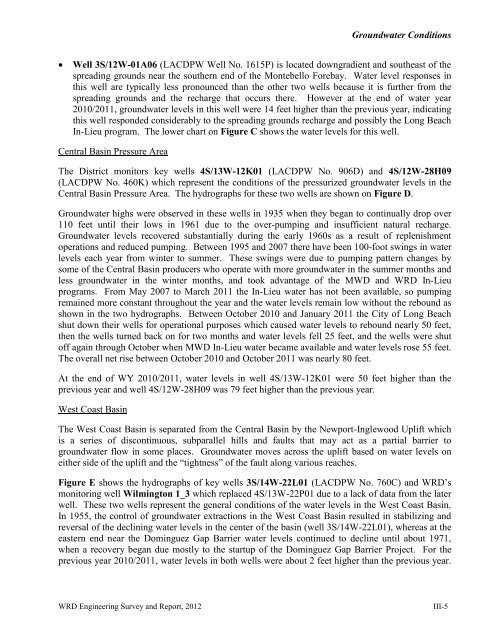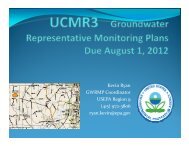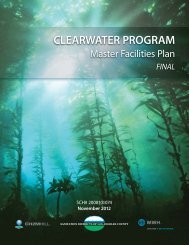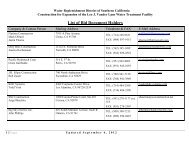Download pdf - Water Replenishment District of Southern California
Download pdf - Water Replenishment District of Southern California
Download pdf - Water Replenishment District of Southern California
You also want an ePaper? Increase the reach of your titles
YUMPU automatically turns print PDFs into web optimized ePapers that Google loves.
Groundwater Conditions<br />
<br />
Well 3S/12W-01A06 (LACDPW Well No. 1615P) is located downgradient and southeast <strong>of</strong> the<br />
spreading grounds near the southern end <strong>of</strong> the Montebello Forebay. <strong>Water</strong> level responses in<br />
this well are typically less pronounced than the other two wells because it is further from the<br />
spreading grounds and the recharge that occurs there. However at the end <strong>of</strong> water year<br />
2010/2011, groundwater levels in this well were 14 feet higher than the previous year, indicating<br />
this well responded considerably to the spreading grounds recharge and possibly the Long Beach<br />
In-Lieu program. The lower chart on Figure C shows the water levels for this well.<br />
Central Basin Pressure Area<br />
The <strong>District</strong> monitors key wells 4S/13W-12K01 (LACDPW No. 906D) and 4S/12W-28H09<br />
(LACDPW No. 460K) which represent the conditions <strong>of</strong> the pressurized groundwater levels in the<br />
Central Basin Pressure Area. The hydrographs for these two wells are shown on Figure D.<br />
Groundwater highs were observed in these wells in 1935 when they began to continually drop over<br />
110 feet until their lows in 1961 due to the over-pumping and insufficient natural recharge.<br />
Groundwater levels recovered substantially during the early 1960s as a result <strong>of</strong> replenishment<br />
operations and reduced pumping. Between 1995 and 2007 there have been 100-foot swings in water<br />
levels each year from winter to summer. These swings were due to pumping pattern changes by<br />
some <strong>of</strong> the Central Basin producers who operate with more groundwater in the summer months and<br />
less groundwater in the winter months, and took advantage <strong>of</strong> the MWD and WRD In-Lieu<br />
programs. From May 2007 to March 2011 the In-Lieu water has not been available, so pumping<br />
remained more constant throughout the year and the water levels remain low without the rebound as<br />
shown in the two hydrographs. Between October 2010 and January 2011 the City <strong>of</strong> Long Beach<br />
shut down their wells for operational purposes which caused water levels to rebound nearly 50 feet,<br />
then the wells turned back on for two months and water levels fell 25 feet, and the wells were shut<br />
<strong>of</strong>f again through October when MWD In-Lieu water became available and water levels rose 55 feet.<br />
The overall net rise between October 2010 and October 2011 was nearly 80 feet.<br />
At the end <strong>of</strong> WY 2010/2011, water levels in well 4S/13W-12K01 were 50 feet higher than the<br />
previous year and well 4S/12W-28H09 was 79 feet higher than the previous year.<br />
West Coast Basin<br />
The West Coast Basin is separated from the Central Basin by the Newport-Inglewood Uplift which<br />
is a series <strong>of</strong> discontinuous, subparallel hills and faults that may act as a partial barrier to<br />
groundwater flow in some places. Groundwater moves across the uplift based on water levels on<br />
either side <strong>of</strong> the uplift and the “tightness” <strong>of</strong> the fault along various reaches.<br />
Figure E shows the hydrographs <strong>of</strong> key wells 3S/14W-22L01 (LACDPW No. 760C) and WRD’s<br />
monitoring well Wilmington 1_3 which replaced 4S/13W-22P01 due to a lack <strong>of</strong> data from the later<br />
well. These two wells represent the general conditions <strong>of</strong> the water levels in the West Coast Basin.<br />
In 1955, the control <strong>of</strong> groundwater extractions in the West Coast Basin resulted in stabilizing and<br />
reversal <strong>of</strong> the declining water levels in the center <strong>of</strong> the basin (well 3S/14W-22L01), whereas at the<br />
eastern end near the Dominguez Gap Barrier water levels continued to decline until about 1971,<br />
when a recovery began due mostly to the startup <strong>of</strong> the Dominguez Gap Barrier Project. For the<br />
previous year 2010/2011, water levels in both wells were about 2 feet higher than the previous year.<br />
WRD Engineering Survey and Report, 2012<br />
III-5









